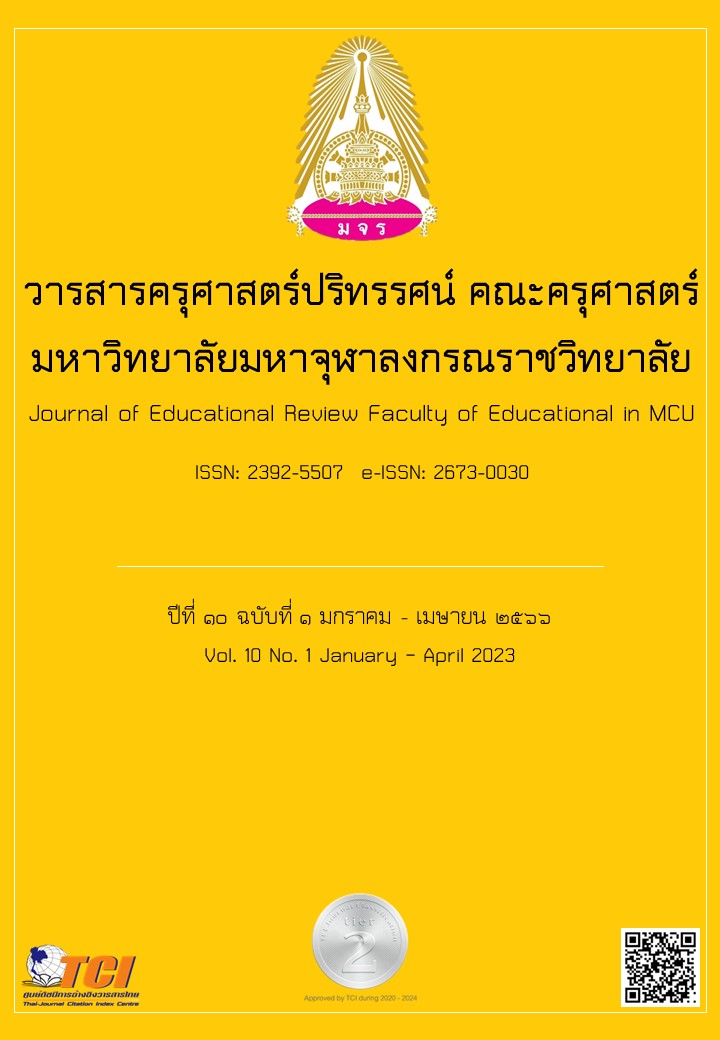THE EFFECTS OF USING HARROW’S INSTRUCTIONAL MODEL ON BENCH WORKS SUBJECT FOR VOCATIONAL EDUCATION CERTIFICATE STUDENTS
Main Article Content
Abstract
The purposes of this research were; 1) to compare if there was a difference in learning achievement of students who were studied using Harrow's Instructional model on bench works subject, unit of filing with criterion of 60 percent. 2) to compare if there was a difference in filing skill score of students who were studied using Harrow's Instructional model on bench works subject, unit of filing with criterion of 70 percent. 3) to study the students’ attitude towards learning activities by using Harrow's Instructional model. The samples consisted of a class 33 students who were selected of cluster random sampling. The research instruments were 5 lesson plans with using Harrow's Instructional model, learning achievement test, filing skill test, and attitude test. The statistic uesd for data analysis were percentage, means, standard deviation, and t-test. The results of this research were as follows: 1) The posttest score of first year vocational certificate students who were studied using Harrow's Instructional model, was 84.23 %, which significantly higher than criterion of 60 percent at the .05 level. 2) The filing skill score of first year vocational certificate students who were studied using Harrow's Instructional model, was 82.21 %, which significantly higher than criterion of 70 percent at the .05 level. 3) The level of student's attitude towards learning activities by using Harrow's Instructional model were rated at high level.
Article Details

This work is licensed under a Creative Commons Attribution-NonCommercial-NoDerivatives 4.0 International License.
ทัศนะและความคิดเห็นที่ปรากฏในบทความในวารสารฉบับนี้ถือเป็นความรับผิดชอบของผู้เขียนบทความนั้นเพียงผู้เดียว และไม่ถือเป็นทัศนะและความรับผิดชอบของกองบรรณาธิการ
กองบรรณาธิการขอสงวนสิทธิ์ในการคัดเลือกบทความลงตีพิมพ์และจะแจ้งให้เจ้าของบทความทราบหลังจากผู้ประเมินบทความตรวจอ่านบทความแล้ว
ต้นฉบับที่ได้รับการตีพิมพ์ในวารสารครุศาสตร์ปริทรรศน์ คณะครุศาสตร์ มหาวิทยาลัยมหาจุฬาลงกรณราชวิทยาลัย ถือเป็นกรรมสิทธิ์ของคณะครุศาสตร์ มหาวิทยาลัยมหาจุฬาลงกรณราชวิทยาลัย ห้ามนำข้อความทั้งหมดหรือบางส่วนไปพิมพ์ซ้ำ เว้นเสียแต่ว่าจะได้รับอนุญาตจากมหาวิทยาลัยฯ เป็นลายลักษณ์อักษร
References
กาญจนี ฉันสิมา. (2553). ผลการจัดกิจกรรมการเรียนรู้สาระนาฏศิลป์ เรื่อง เซิ้งเก็บสมุนไพรในสะเดา ชั้นประถมศึกษาปีที่ 5 โรงเรียนบ้านยาง(อาสาพัฒนา 3) ตามแนวคิดของแฮร์โรว์. วิทยานิพนธ์การศึกษามหาบัณฑิต. มหาวิทยาลัยมหาสารคาม.
กิตติพงษ์ แหน่งสกุล (2557). การพัฒนาผลสัมฤทธิ์ทางการเรียนและทักษะการปฏิบัติงาน เรื่อง การใช้โปรแกรมประมวลผลคำ กลุ่มสาระการเรียนรู้การงานอาชีพและเทคโนโลยีของนักเรียนชั้นประถมศึกษาปีที่ 6 โดยใช้วิธีสอนแบบชี้แนะร่วมกับรูปแบบการเรียนการสอนทักษะปฏิบัติของแฮร์โรว์. วิทยานิพนธ์ศึกษาศาสตรมหาบัณฑิต. มหาวิทยาลัยหาดใหญ่.
กุณฑล หนูทวล. (2560). การพัฒนาผลสัมฤทธิ์ทางการเรียนรายวิชาคอมพิวเตอร์และสารสนเทศเพื่องานอาชีพ ของนักศึกษาระดับประกาศนียบัตรวิชาชีพ โดยใช้รูปแบบการเรียนของแฮร์โรว์ร่วมกับการสาธิต. วิทยานิพนธ์ครุศาสตรมหาบัณฑิต. มหาวิทยาลัยราชภัฏสงขลา.
จิตติ มีสุข. (2555). การพัฒนาผลการเรียนรู้ที่เน้นทักษะปฏิบัติตามแนวคิดของแฮร์โรว์ เรื่อง การเขียนภาพ ISOMETRIC กลุ่มสาระการเรียนรู้การงานอาชีพและเทคโนโลยี ชั้นมัธยมศึกษาปีที่ 1. วิทยานิพนธ์การศึกษามหาบัณฑิต. มหาวิทยาลัยมหาสารคาม.
ทิศนา แขมมณี. (2555). ศาสตร์การสอน องค์ความรู้เพื่อการจัดกระบวนการเรียนรู้ที่มีประสิทธิภาพ. กรุงเทพมหานคร: สำนักพิมพ์แห่งจุฬาลงกรณ์มหาวิทยาลัย.
นันทิยา สงวนตระกูล. (2554). การพัฒนากิจกรรมการเรียนรู้โดยใช้เทคนิคการสอนทฤษฏีแนวคิดแฮร์โรว์ ที่มีต่อทักษะกระบวนการปฏิบัติของนักเรียน เรื่อง การปั้น ชั้นมัธยมศึกษาปีที่ 1. วิทยานิพนธ์การศึกษามหาบัณฑิต. มหาวิทยาลัยมหาสารคาม.
วิทยาลัยเทคโนโลยีวิศวกรรมแหลมฉบัง. (2562). รายงานประเมินคุณภาพภายใน ปีการศึกษา 2561. ชลบุรี: วิทยาลัยเทคโนโลยีวิศวกรรมแหลมฉบัง.
สํานักงานคณะกรรมการการอาชีวศึกษา. (2562). หลักเกณฑ์และแนวปฏิบัติการจัดการอาชีวศึกษา ระดับประกาศนียบัตรวิชาชีพ และระดับประกาศนียบัตรวิชาชีพชั้นสูง เรื่องที่ 7 การวัดและประเมินผลอาชีวศึกษา. กรุงเทพมหานคร: สํานักงานคณะกรรมการการอาชีวศึกษา.
สํานักงานคณะกรรมการการอาชีวศึกษา. (2562). หลักสูตรประกาศนียบัตรวิชาชีพ พุทธศักราช 2562. กรุงเทพมหานคร: สํานักงานคณะกรรมการการอาชีวศึกษา.


